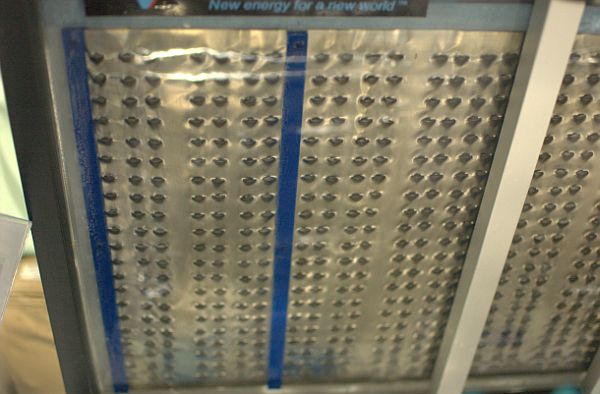
Electric cars are definitely a green way to commute, however, when operating range is a concern, green vehicles that are propelled by easily refillable fuels like hydrogen take the podium. But the problem with hydrogen is its generation, which isn’t as clean as the end product is. We’ve seen many companies coming up with hydrogen generators that run on solar power and one such company is Nanoptek. The Maynard, Massachusetts-based company has started taking orders for a solar-powered hydrogen generator that splits water into its constituent atoms – hydrogen and oxygen, out of which hydrogen is harnessed.
Nanoptek aims at producing hydrogen gas in large scale harnessing solar energy required for vehicles and domestic purposes. From a short term perspective, this company is aiming to provide solar hydrogen generators to the industrial houses whose hydrogen requirement is high. The currently designed product, a2 meter wide and one meter high Solar Hydrogen Generator 300, functions as a conventional electrolyzer, where electric current is applied to electrolyze water into hydrogen and oxygen, the only difference being that this solar generator requires one third of the electric energy compared to conventional electrolysis of water.
The presence of a titanium dioxide coating, which gets activated by ultraviolet and visible blue light of the solar spectrum, produces the energy required for splitting water. Titanium dioxide with its exceptional UV absorption capabilities has high potential in unconventional forms of energy production. It can function as a very active photocatalyst and cause hydrolysis, splitting of water into hydrogen cation and hydroxyl anion.
Titanium dioxide, also known as Anatase is heated at high temperature, which is further converted into nanoparticles before application of the coating. The nanostructure form of titanium dioxide excites the electrons with the application of low energy visible blue light, producing the electron flow necessary for the splitting of water into hydrogen and oxygen.
Titanium dioxide acts as an exceptional photocatalyst that can initiate photochemical reaction upon application of very low energy. Therefore, this nanostructured solar panel can be productive even in cloudy days. In the absence of sunlight, this solar hydrogen generator can be
connected to the main grid for power to carry out electrolysis of water. Nanoptek solar generator panels contain a row of photovoltaic cells along with the titanium strips for better efficiency in hydrogen production. Photovolatic cells supply extra voltage for electrolysis of water fastening the hydrogen production.
Certain technical difficulties still prevent the mass usage of hydrogen gas as an alternate energy source. Hydrogen gas cannot be easily compressed into liquid forms, and its storage is another problem. There is no infrastructure for hydrogen gas transportation besides the tankers. Still, the use of this gas as an energy carrier is quite luring in the present context of high energy demand, and researches are on for inexpensive hydrogen gas extraction.
Source: CNet




